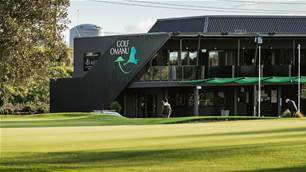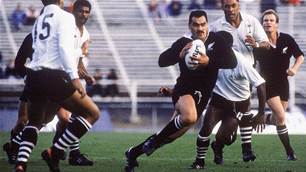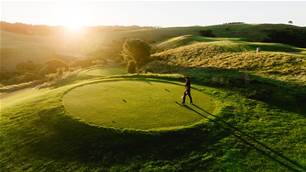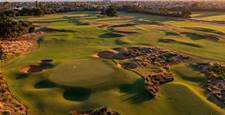I count myself among the tens of thousands of golfers who have visited this Queensland holiday haven.
I count myself among the tens of thousands of golfers who have visited this Queensland holiday haven.
Next year marks the 20th anniversary of a Gold Coast golfing institution – Links Hope Island.
I count myself among the tens of thousands of golfers who have visited the Queensland holiday haven during the past two decades and had one must-play course underlined on their itinerary. It is testament to the quality of the layout and the Hope Island facilities that our love affair with the Peter Thomson and Mike Wolveridge-designed links has never waned.
But I, like so many visiting golfers, assumed our days of playing this fine course were numbered when the club announced a few years back that it was going private. Such announcements are usually accompanied by fewer or no tee times being made available for the public. This is certainly not the case at Hope Island where visiting golfers can still access the course seven days a week, which was confirmed with the layout’s eligibility and No.15 position in Golf Australia’s ranking of the Top-100 Public Access Courses in 2011. It was also ranked in our list of the nation’s Top-100 Courses earlier this year.
“There has been a misconception that Links Hope Island is already private,” the club’s general manager, Mark Holland, says. “A lot of people say, ‘Oh, I thought I couldn’t get on anymore,’ but we are enthusiastic about welcoming visitors to our club.
“While Links Hope Island is transitioning to private equity membership, the opportunity still exists for public rounds as well as special events. The public is most welcome to enjoy our clubhouse, restaurant and bar facilities and to access the course outside of the allocated member tee times,” Holland added.
This is music to the ears of golfers, like me, who regularly visit the Gold Coast and rarely return home without having played the course. The reason we keep returning is the combination of a range of factors including a challenging course that is always in superb condition, friendly service and the outstanding facilities. ‘Five-star’ is the benchmark across the board and that is something every visiting golfer returning to Hope Island knows they will experience. For mine, a round at Hope Island is like going home to your mum’s for a Sunday roast lunch – you know it’s going to taste really good because it always does, you will be welcomed with open arms, you’ll have a great time and, when it’s time to go home, you will start thinking the next visit can’t come quick enough.
If you haven’t already guessed it, Links Hope Island is one of my favourite courses in Queensland. I don’t think I’m Robinson Crusoe in this regard and its popularity extends way back to 1993 when the Links Hope Island first opened for play.
Back then, it was a unique addition to the Australian golfing landscape – a links-style layout seemingly uprooted from its Scottish location and transplanted on the sunny northern outskirts of the Gold Coast.
At that time, Australian golfers had not experienced anything like it before (or since) and, as a result, Hope Island achieved instant popularity. Problems with conditioning in the late ’90s saw its star tarnished for a brief period. But these problems were addressed more than a decade ago with the replacement of its original Bent grass greens with the hardier Bermuda 328 grass, which is more suitable to warmer climates.
Adding to Hope Island’s popularity is that it is challenging and fair to players of all standards, which is the hallmark of all high quality courses. Thomson and Wolveridge were able to achieve this delicate balance between difficulty and fairness by presenting wide fairways that offer a series of routes and playing options on each hole. While the mid- or high-handicapper can enjoy the freedom (and lack of lost balls) offered by the wide avenues between tee and green, the better player must play precisely to the edges of the fairways to leave the best approach into greens that are generally protected by trimmed mounds, swales and deep pot bunkers.
The bunkering is one of the standout features of the Links Hope Island – and for good reason. Thomson once wrote: “Bunkers, of course, are as important to a course as greens and tees and we never neglect their inclusion.”
He certainly didn’t neglect them at Hope Island and while the bunkering is plentiful, it is not overdone and their placement has a major role in determining your playing strategy. Working out the right playing line, in the conditions of the day, on each hole is part of the enjoyment of a round at Hope Island.
This is especially true on some of the short par-4s, where the length of the hole doesn’t really matter. What does matter at Hope Island, more than at many other courses, is making the correct club selection on the tee, selecting the right line, and executing the shot accordingly.
And as if the game of golf weren’t tough enough, Thomson has schemed to add further uncertainty into the minds of golfers on the tee. Like MacKenzie, he has made clever use of the fairway bunkering, leaving you sometimes confused when judging their distance and size. It’s quite a deception: some bunkers you’d swear you couldn’t reach with your best shot, yet you’ll find a mere average blow will put you in it. The opposite also applies. (Thankfully, the GPS in your golf cart can assist if need be.)
The first example of this comes early in the round at the 501-metre par-5 2nd hole where a lone pot bunker on the left edge of the fairway dictates a playing line to the right. This is a hole where only the longest of hitters can reach the green in two shots so finding a suitable lay-up position is important. The closer you hit toward the green with your second shot, the smaller the landing area – between five pot bunkers – becomes. Play well short of these sandy hazards to leave a full wedge or short iron into a slightly raised green.
Bunkers also have a narrowing effect on the driving zone of the 368-metre par-4 9th. Two cavernous pots left of the fairway and three staggered traps along the right edge of the driving zone leave little room for error. But if you are game, take on the traps to the left and find the wide tongue of fairway beyond. It is a risky shot though, as finding any one of the five fairway traps here will result in a bogey at best.
Arguably Hope Island’s best hole is the 369-metre par-4 13th, known as ‘Wetlands’. It’s a dogleg left around a lake to a green that features a ridge running through the middle of it. The real features of this hole, though, are the fairway bunkers, the round, crater-like pits that have become synonymous with Thomson designs. Position your drive as close to the water as you dare to provide the shortest, most forgiving route to the flag over three more deep greenside pot bunkers. That said, there is more room on the fairway between the left and right crop of bunkers than it appears as you stand on the tee. A line just left of the right traps will leave a much longer approach but the angle will have you playing straight up the green, instead of over the greenside pot bunkers.
If it has been a while since you trod Hope Island’s fairways and greens, get back there. It remains an enjoyable and memorable experience, just like your mum’s Sunday lunch … it’s probably even better (sorry Mum).
FACT FILE
THE COURSE
LOCATION: Hope Island Rd, Hope Island, Gold Coast, Queensland. About 25 minutes’ drive north of Surfers Paradise, 40 minutes south of Brisbane.
CONTACT: (07) 5530 9000.
WEBSITE: www.linkshopeisland.com.au
DESIGNERS: Peter Thomson & Mike Wolveridge (1993).
PLAYING SURFACES: Couch fairways and tees, Bermuda Tifdwarf greens. BUNKERS: 128.
PGA PRO: Ben Cousins.
GREEN FEES: $140 (Mon-Thurs), $150 (Fri-Sun). Includes cart with colour GPS.
THE CLUB
MEMBERSHIPS: Links Hope Island offers equity membership, which offers a wide range of benefits beyond access to the golf course. For further information contact Director of Sales, Leigh Milne on (07) 5530 9023.
CORPORATE AND GROUP DAYS: To make sure your corporate day is a success, Hope Island’s highly professional team will take care of every aspect of the day, including concierge bag drop, provision of warm-up practice balls, fully equipped golf carts with GPS navigation as well as an ice box for lunch and refreshments among the many offers.
ACCOMMODATION: The neighbouring Azzura Greens Resort offers guests the choice of luxury one- or
two-bedroom deluxe or two-bedroom executive apartments all furnished with plush modern fixtures and large balconies.
ACCOLADES: Ranked by Golf Australia magazine in the nation’s Top-100 Courses in 2012; No.15 in Top-100 Public Access Courses ranking 2011.
Related Articles

International Spotlight: Omanu Golf Club

Celebrity Kiwi couple tee off in paradise



.jpg&h=115&w=225&c=1&s=1)









